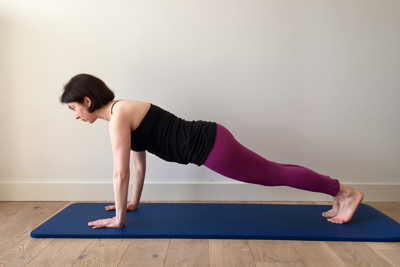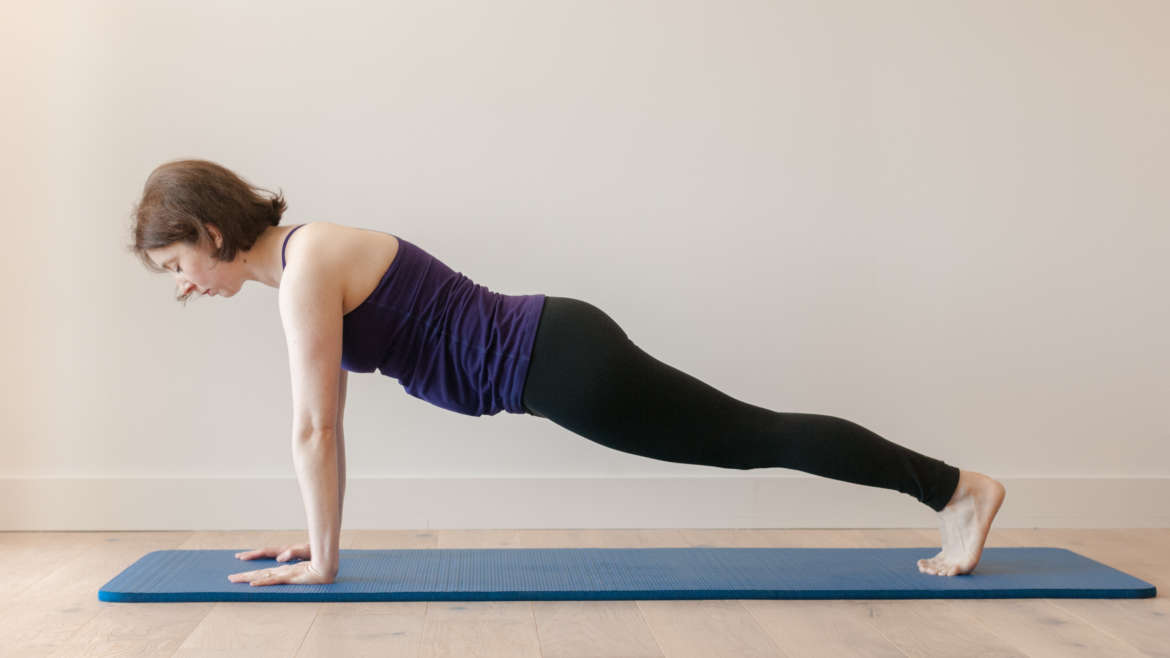This spring I thought it would be fun to do a simple challenge with one exercise to complement your weekly or bi-weekly Pilates class and to throw into your home workout. For those who do not workout at home yet here's the perfect opportunity to try to do a little something: the Pilates Plank Challenge!
I've put together a short video for you to explain how to properly do the Pilates plank:
Why the Pilates Plank?
- The plank position is inherently challenging, executed properly the whole body is engaged in maintaining it.
- C’est la base pour de nombreux exercices de Pilates avancés sur le tapis et sur les appareils. Améliorer votre planche vous fera progresser dans votre pratique du Pilates.
- Pour faire la planche, vous n’avez besoin ni de beaucoup de temps, ni de vêtements spécifiques, pas plus que de matériel particulier. C’est facile à faire n’importe quand au cours de la journée.
How do I do a Pilates Plank?
Ceci est un défi Pilates et non un défi “fitness” nous allons donc prendre particulièrement soin de veiller :
- Your Form
- A l’amélioration de votre connaissance de votre propre corps
- Your Working Level
Your form
Correctly maintaining the position works the whole body. If you can do your plank with a mirror nearby to start, that could be helpful!
Your form checklist, is what to pay attention to from head to toe:
- Le sommet de votre crane va vers l’avant, vos talons s’étirent vers l’arrière ;
- Votre corps est long et rectiligne comme une planche. Votre bassin n’est ni trop haut ni en train de tomber vers le bas ;
- Your hands and arms are placed just beneath your shoulders, shoulder width;
- Your elbows are straight but, not locked or hyper extended, this is extremely important for building arm strength and not stressing your ligaments!
- Your fingers are spread apart and the whole palm of the hand, 4 fingers and thumb are pressing;
- The backs of the legs are active and lifting upward energetically.
L’amélioration de votre connaissance de votre propre corps
Faire la planche Pilates veut dire se concentrer sur votre respiration et sur l’engagement de vos abdominaux.
- Inhale into your whole rib cage and exhale to draw your belly in without changing your plank.
- When you feel the position getting harder continue to focus on your breath.
- Restez dynamique et le corps entier travaillera. Commencez à vous effondrer quelque part et le reste du corps s’effondra doucement.
- Observe, without judging, which area feels stronger, which area needs to work harder.
- Feel free to take notes each day after holding your plank to log progress.
Your Working Level
- Pour commencer, trouvez la position que vous pouvez maintenir à la durée qui convient à votre niveau d’aujourd’hui. Le but est et de progresser mais commencez là où vous êtes à l’aise et non pas où vous luttez.
- Si vous avez des problèmes avec une épaule, un coude, un poignet ou le bas du dos qui vous inquiète vous pouvez démarrer avec la version modifiée de la planche sur les avants bras, voir la photo. Cette version n’est pas forcément plus facile, mais elle protège les zones indiquées en cas de blessures, tensions ou grandes faiblesses.
- L’écoute de votre corps et le respect de votre niveau sont essentiels dans la quête de mieux connaître son corps et d’avancer sainement dans sa pratique de Pilates.
The schedule
One of the goals of this Pilates Plank Challenge is to increase your body awareness so I encourage you to regulate where you start and how you ramp up, here are my suggestions:
- Start by timing yourself holding the plank and see how long you can hold it for comfortably, start your Challenge there.
- Do your plank for 3 days at your established start duration.
- Rest for 1 day.
- Ramp up for 5-10 seconds for the next 3 days.
- Rest for 1 day.
- Continue in this manner for a total of 30 days.
Doing The Pilates Plank
- Start on hands and knees with hands just below shoulders and knees just below hips

Start Position - unmodified version
- If doing the modified version on the forearms, start on the forearms not on the hands.

Start Position - modified version
- Etirez une jambe vers l’arrière et appuyer sur le coussinet du pied. Repositionner votre poids sur vos mains et votre jambe arrière.
- Etirez l’autre jambe vers l’arrière. Redistribuer le poids de votre corps sur ces 4 appuis.

Proper Position for the Pilates Plank
- Run through the Form Check-List above;

Example of pelvis too high

Example of pelvis too low
- Focus on your breath and your abdominals for the pre-determined duration, feel free to use a timer;
- Pour terminer, posez un genou, puis un autre. Appuyez dans vos mains pour vous asseoir dans la position de l’enfant et y rester pour quelques respirations.

La position de l’enfant
- Take a few notes, then continue your day!
I encourage you to keep a log with brief notes so you can observe your progress, you can use this log template . Feel free to share your observations and any questions you might have with me
Je vous invite vivement à partager vos observations et vos questions avec moi :
- Facebook: https://www.facebook.com/pilates.paris
- email: emily@pilatesdelateteauxpieds.com
Have a great Challenge, I look forward to reading your feedback!



